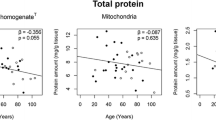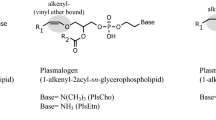Abstract
The ethanolamine plasmalogens are decreased whereas serine glycerophospholipids are significantly increased in plasma membrane phospholipid in affected regions of brain in Alzheimer's disease. This may be due to stimulation of Ca2+-independent plasmalogen-selective phospholipase A2, which was recently discovered in brain. This phospholipase A2 differs from other Ca2+-independent phospholipases A2 in response to ATP and various inhibitors. It may be responsible for excess release of arachidonic acid and accumulation of prostaglandins and lipid peroxides in AD. Accumulation of the above lipid metabolites due to abnormal receptor function and signal transduction may contribute to neurodegeneration in AD.
Similar content being viewed by others
REFERENCES
Selkoe, D. J. 1991. The molecular pathology of Alzheimer's disease. Neuron 6:487–498.
Arispe, N., Pollard, H. B., and Rojas, E. 1994. β-amyloid Ca2+-channel hypothesis for neuronal death in Alzheimer's Disease. Mol. Cell. Biochem. 140:119–125.
Katzman, R., and Saitoh, T. 1991. Advances in Alzheimer's disease. FASEB J. 5:278–286.
Farooqui, A. A., Wells, K., and Horrocks, L. A. 1995. Breakdown of membrane phospholipids in Alzheimer's disease: involvement of excitatory amino acid receptors. Molec. Chem. Neuropathol. 25, 155–173.
McGeer, P. L., Rogers, J., and McGeer, E. G. 1994. Neuroimmune mechanisms in Alzheimer's disease pathogenesis. Alzheimer Disease and Associated Disorders 8:149–158.
Ginsberg, L., Atack, J. R., Rapoport, S. I., and Gershfeld, N. L. 1993. Evidence for a membrane lipid defect in Alzheimer's disease. Mol. Chem. Neuropathol. 19:37–46.
Roth, G. S., Joseph, J. A., Mason, R. P. 1995. Membrane alterations in Alzheimer's disease and aging—Reply. Trends. Neurosci. 18:484.
Ying, W. 1996. Deleterious network hypothesis of alzheimer's disease. Med. Hypoth. 46:421–428.
Farooqui, A. A., Liss, L., and Horrocks, L. A. 1988. Neurochemical aspects of Alzheimer's disease: Involvement of membrane phospholipids. Metabolic Brain Dis. 3:19–35.
Nitsch, R., Pittas, A., Blusztajn, J. K., Slack, B. E., Growdon, J. H., and Wurtman, R. J. 1991. Alterations of phospholipid metabolites in postmortem brain from patients with Alzheimer's disease. Ann. NY Acad. Sci. 640:110–113.
Nitsch, R. M., Blusztajn, J. K., Pittas, A. G., Slack, B. E., Growdon, J. H., and Wurtman, R. J. 1992. Evidence for a membrane defect in Alzheimer's disease brain. Proc. Natl. Acad. Sci. USA 89:1671–1675.
Söderberg, M., Edlund, C., Kristensson, K., and Dallner, G. 1990. Lipid compositions of different regions of the human brain during aging. J. Neurochem. 54:415–423.
Horrocks, L. A., and Fu, S. C. 1978. Pathway for hydrolysis of plasmalogens in brain. Adv. Exp. Med. Biol. 101:397–406.
Stokes, C. E., and Hawthorne, J. N. 1987. Reduced phosphoinositide concentration in anterior temporal cortex of Alzheimer's diseased brains. J. Neurochem. 48:1018–1021.
Farooqui, A. A., Liss, L., and Horrocks, L. A. 1990. Elevated activities of lipases and lysophospholipases in Alzheimer's disease. Dementia 1:208–214.
Pettegrew, J. W., Moossy, J., Withers, G., McKeag, D., and Panchalingam, K. 1988. 31P Nuclear magnetic resonance study of the brain in Alzheimer's disease. J. Neuropathol. Exp. Neurol. 47:235–248.
Pettegrew, J. W. 1989. Molecular insights into Alzheimer's disease. Ann. NY Acad. Sci. 568:5–28.
Iwamoto, N., Kobayashi, K., and Kosaka, K. 1989. The formation of prostaglandins in the postmortem cerebral cortex of Alzheimer-type dementia patients. J. Neurol. 236:80–84.
Jeandel, C., Nicolas, M. B., Dubois, F., Nabet-Belleville, F., Penin, F., and Cuny, G. 1989. Lipid peroxidation and free radical scavengers in Alzheimer's disease. Gerontology 35:275–282.
Subbarao, K. V., Richardson, J. S., and Ang, L. C. 1990. Autopsy samples of Alzheimer's cortex show increased peroxidation in vitro. J. Neurochem. 55:342–345.
Volicer, L., and Crino, P. B. 1990. Involvement of free radicals in dementia of the Alzheimer type: A hypothesis. Neurobiol. Aging 11:567–571.
Pettegrew, J. W., Klunk, W. E., Kanal, E., Panchalingam, K., and McClure, R. J. 1995. Changes in brain membrane phospholipid and high-energy phosphate metabolism precede dementia. Neurobiol. Aging 16:973–975.
Horrocks, L. A., Spanner, S., Mozzi, R., Fu, S. C., D'Amato, R. A., and Krakowka, S. 1978. Plasmalogenase is elevated in early demyelinating lesions. Adv. Exp. Med. Biol. 100:423–438.
Nakayama, R., and Saito, K. 1989. Presence of 1–0-alk-1'-enyl–2–0-acetyl-glycerophosphocholine (vinyl form of PAF) in perfused rat and guinea pig hearts. J. Biochem. 105:494–496.
Chao, W., and Olson, M. S. 1993. Platelet-activating factor: receptors and signal transduction. Biochem. J. 292:617–629.
Zoeller, R. A., Morand, O. H., and Raetz, C. R. H. 1988. A possible role for plasmalogens in protecting animal cells against photosensitized killing. J. Biol. Chem. 263:11590–11596.
Glaser, P. E., and Gross, R. W. (1994) Plasmenylethanolamine facilitates rapid membrane fusion: A stopped-flow kinetic investigation correlating the propensity of a major plasma membrane constituent to adopt an HII phase with its ability to promote membrane fusion. Biochemistry 33:5805–5812.
Wells, K., Farooqui, A. A., Liss, L. and Horrocks, L. A. (1995) Neural membrane phospholipids in Alzheimer's disease. Neurochem. Res. 20, 1329–1333.
Ginsberg, L., Rafique, S., Xuereb, J. H., Rapoport, S. I., and Gershfeld, N. L. 1995. Disease and anatomic specificity of ethanolamine plasmalogen deficiency in Alzheimer's disease brain. Brain Res. 698:223–226.
Hirashima, Y., Farooqui, A. A., Mills, J. S., and Horrocks, L. A. 1992. Identification and purification of calcium-independent phospholipase A2 from bovine brain cytosol. J. Neurochem. 59:708–714.
Yang, H.-C., Farooqui, A. A., and Horrocks, L. A. 1994. Effects of glycosaminoglycans and glycosphingolipids on cytosolic phospholipases A2 from bovine brain. Biochem. J. 299:91–95.
Farooqui, A. A., Yang, H.-C. and Horrocks, L. A. 1995. Plasmalogens, phospholipases A2, and signal transduction. Brain Res. Rev. 21, 152–161.
Yang, H.-C., Farooqui, A. A. and Horrocks, L. A. 1994. Effects of sialic acid and sialoglycoconjugates on cytosolic phospholipases A2 from bovine brain. Biochem. Biophys. Res. Commun. 199, 1158–1166.
Yang, H.-C., Farooqui, A. A. and Horrocks, L. A. 1996. Purification and characterization of Ca2+-independent plasmalogen selective phospholipase A2 FASEB J. 10, A986.
Hazen, S. L., and Gross, R. W. 1991. ATP-dependent regulation of rabbit myocardial cytosolic calcium-independent phospholipase A2. J. Biol. Chem. 266:14526–14534.
Hazen, S. L., and Gross, R. W. 1991. Human myocardial cytosolic Ca2+-independent phospholipase A2 is modulated by ATP. Concordant ATP-induced alterations in enzyme kinetics and mechanism-based inhibition. Biochem. J. 280:581–587.
Ackermann, E. J., Kempner, E. S., and Dennis, E. A. 1994. Ca2+-independent cytosolic phospholipase A2 from macrophage-like P388D1 cells. Isolation and characterization. J. Biol. Chem. 269:9227–9233.
Farooqui, A. A., Hirashima, Y., and Horrocks, L. A. 1992. Brain phospholipases and their role in signal transduction, in Neurobiology of Essential Fatty Acids (Bazan, N. G., Toffano, G., and Murphy, M. eds), pp. 11–25. Plenum Press, New York.
Stephenson, D. T., Lemere, C. A., Seldoe, D. J., and Clemens, J. A. 1996. Cytosolic phospholipase A2 (cPLA2) immunoreactivity is elevated in Alzheimer's disease brain. Neurobol. Dis. 3, 51–63.
Halliwell, B. 1994. Free radicals and antioxidants: a personal view. Nutr. Rev. 52, 253–265.
Jenner, P. 1994. Oxidative damage in neurodegenerative disease. Lancet 344, 796–798.
Chen, L., Richardson, J. S., Caldwell, J. E., and Ang, L. C. 1994. Regional brain activity of free radical defense enzymes in autopsy samples from patients with Alzheimer's disease and from non-demented controls. Int. J. Neurosci. 75, 83–90.
Masliah, E., Mallory, M., Hansen, L., DeTeresa, R., and Terry, R. D. 1993. Quantitative synaptic alterations in the human neocortex during normal aging. Neurology 43:192–197.
Farooqui, A. A., and Horrocks, L. A. 1994. Involvement of glutamate receptors, lipases, and phospholipases in long-term potentiation and neurodegeneration. J. Neurosci. Res. 38:6–11.
Novelli, A., Reilly, J. A., Lysko, P. G., and Henneberry, R. C. 1988. Glutamate becomes neurotoxic via the N-methyl-D-aspartate receptor when intracellular energy levels are reduced. Brain Res. 451:205–212.
Hazen, S. L., Stuppy, R. J., and Gross, R. W. 1990. Purification and characterization of canine myocardial cytosolic phospholipase A2. J. Biol. Chem. 265:10622–10630.
Ackermann, E. J. and Dennis, E. A. 1995. Mammalian calcium-independent phospholipase A2. Biochim. Biophys. Acta Lipids Lipid Metab. 1259, 125–136.
Clark, J. D., Milona, N., and Knopf, J. L. 1990. Purification of a 110-kilodalton cytosolic phospholipase A2 from the human monocytic cell line U937. Proc. Natl. Acad. Sci. USA 87:7708–7712.
Author information
Authors and Affiliations
Rights and permissions
About this article
Cite this article
Farooqui, A.A., Rapoport, S.I. & Horrocks, L.A. Membrane Phospholipid Alterations In Alzheimer's Disease: Deficiency of Ethanolamine Plasmalogens. Neurochem Res 22, 523–527 (1997). https://doi.org/10.1023/A:1027380331807
Issue Date:
DOI: https://doi.org/10.1023/A:1027380331807




